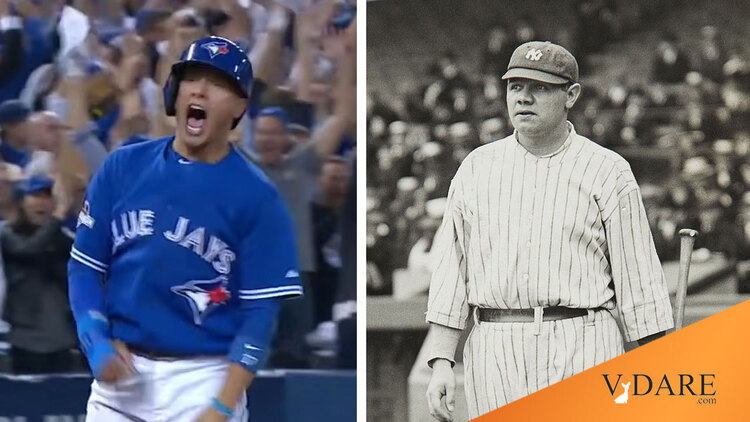
When Did Home Run Hitters Start Posing at Home Plate?
08/26/2023
An interesting historical question is when the culture changed from baseball sluggers modestly running toward first base upon crushed contact as if their homers might not clear the fence to standing at the plate to admire their mighty blasts. Ballplayers can tell with a high degree of accuracy when they’ve ripped a home run, so whether they immediately start to run the bases as if their hit might not clear the fences or not tends to be a matter of culture. On the other hand, American athletes didn’t believe in humiliating their foes in the middle of the 20th century by acting as if they were sure they’d homered. But in this century they do.
For example here is Jose Bautisa in the 2015 playoffs hitting a home run:
For instance, on the rare occasions when as a golfer I hit a good drive off the tee, I tend to stand rooted in one spot admiring it until it stops rolling. But pro golfers often modestly/arrogantly immediately bend over to pick up their ten-cent tee and let their caddie keep an eye on where the ball winds up (right down the middle, 335 yards away).
Flipping your bat like Bautista did was anathematized in kid baseball 50+ years ago because your bat might come down on the catcher’s or umpire’s head. Kids can’t fling their bat as far as big leaguers can, so, paradoxically, bat-throwing is more dangerous at the little league level.
But I suspect that the development of the batter’s helmets led to more posing at home plate due to less fear of retribution from a pitcher’s beanball.
It was not always so.
For example, Babe Ruth was not a modest man, but the video of his last home six homers in 1927 when he broke his own record of 59 homers, shows him trotting toward first each time, even on his 60th in his last at-bat of the season.
A few minutes later in the locker room, he is said to have said: “Sixty! Count ’em, sixty! Let’s see some other son of a bitch match that!” But he didn’t pose on the field when he hit #60, even though he obviously could tell it was gone. Just seven years before, shortstop Ray Chapman had been killed by Carl Mays’ pitch. It seems unlikely that any pitcher would have thrown at the head of Ruth, who had made all ballplayers more prosperous. Still, “An armed society is a polite society.”
And here’s Roger Maris’s 61st homer in 1961: Maris is running toward first base from contact as if he can’t tell he’s done it, he’s broken Babe Ruth’s record, the most famous record in American sports:
Now, here is Aaron Judge, the third Yankee to set the American League single season, hitting #62 last season. Judge is, for all his accomplishments, not an arrogant man. But in the spirit of the times, he briefly stood awestruck at home at what he’d done, before politely heading toward first as if he were unsure whether it would be #62 or not.
So, when did posing at home to admire your massive blast begin?
Here’s Reggie Jackson, Mr. October, in the final game of the 1977 World Series in perhaps the greatest hitter’s game in World Series history:
I can’t tell if he immediately runs on his first home run. He definitely is off running on contact on his second blast.
But on his majestic third homer, he momentarily pauses at the plate to appreciate the moment.
You could hardly blame him.
Four years later, here’s Reggie in a 1981 game of the Yankees vs. the Indians. Pitcher John Denny struck out Reggie, which led to a scuffle. And later:
Reggie Jackson would launch a bomb off you and then kick your sorry ass after he crossed home plate.
— Super 70s Sports (@Super70sSports) August 26, 2023
Reggie homered and stood at home plate taking it all in. Upon crossing home plate he exchanged words with Denny, then charged him.
By the 1983 playoffs, bat flips and standing at home plate were admired:
So that seems to be the tipping point, somewhere around 1980.
In the current decade, polite Japanese two-way pitching-hitting star Shohei Ohtani tended to run out his 400-foot smashes until this season when he tended to stand there to appreciate his 450-foot no-doubters. Ohtani ripped his ulnar collateral ligament pitching this week, ending his season as a pitcher. It’s almost as if the human body didn’t evolve to throw 100 mph overhand.
But, ridiculously, he has continued to soldier on as a hitter. Yesterday, he hit a double with an exit velocity of 115 mph:
Shohei Ohtani double!!
His 8th hardest hit ball of the season. With a torn UCL.
— Ben Verlander (@BenVerlander) August 25, 2023
Here’s the most famous photo in boxing history (actually there are two almost identical ones, one in color, one in black and white) of the 1965 Muhammad Ali-Sonny Liston fight:

One theory is that Ali had heard that the fix was in and Liston was going to throw the fight to him, so Ali was sportingly screaming at the crooked Liston to get up and fight like a man. This is not implausible. Ali had his flaws, but he was as great a competitor as any in sports history. The 1965 Sports Illustrated article about the fight by Tex Maule takes great pains to dismiss the theory that because almost nobody saw Ali’s knockout punch that it didn’t happen. But then why protest that theory so hard?
Over time, however, this has become an iconic photo of black dominance / black-on-black violence.
